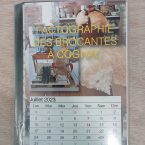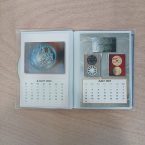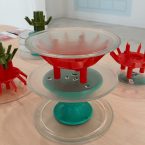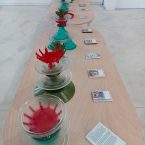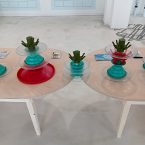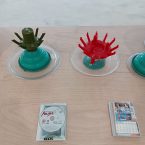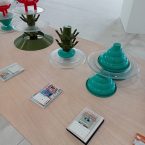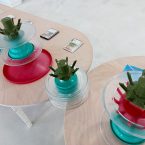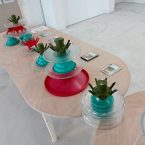Factographie des brocantes à Cognac
Notes on a research residency at the Martell Foundation, as part of the exhibition Almanach.
Ernesto Oroza, July 2023
“If the film you are about to see seems enigmatic to you, life is enigmatic too. The author declares that he did not want to play with symbols, at least consciously. It may be that the best explanation for The Exterminating Angel is that, rationally, it has none…”.
– Luis Buñuel (clarification for the French version of his homonymous film)
Almanach is an exhibition at Fondation d’entreprise Martell. Research and staging of the exhibition by Olivier Peyricot, Lola Carrel, Valentin Patis and Mathilde Pellé.
For 23 days, I interacted with the exhibition, the territory of Cognac (and its surroundings), and its resources. I took up previous research methods and staging experiments to avoid acting as a “researcher in a parachute,” especially due to the time allotted to the residency. In this way, the resources and context of Cognac and the exhibition became vehicles to develop the methods rather than produce results.
Three typologies of artifacts integrate my proposal: a series of edited photo albums; a set of displays made with objects taken from the Emmaüs store in Cognac, which can be returned to the store at the end of the exhibition; a series of laminated photographic calendars that can be reused as doilies.
The following are some notes on the ideas, displays, and relationships I established in this research. As has always been my interest, I have used staging (meaning exhibition) and editing, and publication as tools to interrogate, once again, the object of research. New questions arose by confronting the documents (things, receipts of commercial transactions, photos, and observations) with the needs, codes, technical and language resources, and the history of exhibition practices. In this way, exhibition and publication become research methods that have a productive purpose.
Factography and Photomaton
Factography is a practice of objectively capturing reality, followed by a dialectical montage that seeks to promote a collective hermeneutic. This practice was developed in Russia in the 1920s, among others, by Serguei Tretyakov, a Soviet poet and theatrical artist. Factography postpones individual and subjective interpretation in favor of a public debate. The mural newspaper was the most common montage tool used by Russian factographers on farms and in factories and elaborated in collaboration with the peasants and workers. In this way, Factography became a collective form of publication. Creating the mural transformed the community, generating communal debates and commitment; it led Tretyakov to rename this method of Operative Factography. To develop these murals, their creators started with one or several temporal sequences, such as calendars, timelines, and agendas. Photography was the essential tool in elaborating the murals because of its imprint and ability to capture situations.
The principle and the name Photomaton were invented in NY by the Russian émigré Anatol Josepho in 1925 and imported to Paris in 1928. A year later, some surrealist artists, among them Louis Aragon, Luis Buñuel, Paul Eluard, Salvador Dali, Marx Ernst, and André Breton, used it to produce photographic works based on the automatic, combinatorial, and sequential dynamics allowed by the machine.
In my practice, the first precedent was a small photographic series developed in Cuba in 1999 during a trip around the island with Penelope de Bozzi. To continue photographing the “objects of necessity” we collected, I asked local photographers dedicated to taking photos for official documents such as visas and passports to photograph the objects that I brought to their improvised studios in the living rooms of the houses. The result was a series of B&W photos (visa format) of lamps and kitchen lighters. In doing this project, I realized that I had developed dual documentation: the artifacts photographed and those photographers’ business practices.
In using the Photomaton, and because of the need to insert a notion of time into the photographic records, I decided to use each of the calendar layout options offered by the Photomaton and its options for landscape and portrait photos. This exercise allowed me to document some features of the Photomaton system.
Editing photo albums
The Photomaton inhabits an “ecosystem” designed according to the size of the postcard-like photo it produces. Frames and albums for 10x15cm photos are some of the best-known peripheral objects we can purchase in the markets and second-hand stores. At Emmaüs Cognac, I acquired a group of these albums to make an experimental factographic publication using the resources of the Photomaton. Each of these edited photo albums approaches one or more of the essential topics of this research, such as Factography, reuse, and the very documentation of the use of the Photomaton within the project.
Microwave dishes and the bottle dryer
Microwaves are among the few household appliances repairers reject because of the danger of opening them and exposing themselves to malfunction. For this reason, we discarded them everywhere. The dishes, almost always the only removable part, pile up in second-hand stores without attracting visitors’ interest. During this residency, I collected twenty-three plates at Emmaüs de Cognac. This selection shows diverse designs, dimensions, standards, and formal and structural solutions that facilitate rotation and resistance to use. To present these objects inside the exhibition, I acquired from Emmaüs two modular bottle dryers, which, by separating their sections, allow new combinations between them and with the microwave dishes. The shape of these bottle holders is generally abstract, so their function is difficult to recognize at first glance. It was probably this feature that led Duchamp to appropriate it in 1914. The “Egouttoir or Porte-bouteilles or Hérisson” (Bottle Rack) is his first “pure” readymade. The use I have assigned to these objects in the exhibition is to serve as a display system for microwave plates.
Photo-collages-calendars
A photographic record of these plates became, through one of the Photomaton options, a collection of 23 calendars for July. To understand the size of these plates, and as a field researcher would do, I have photographed them using a recognizable object as a scale index. In this case, a DVD of the film El Ángel Exterminador (1962) by the Spanish surrealist Luis Buñuel. I acquired it at the Emmaüs. The relationship between scale and object of study is assumed here as a rhetorical device to stimulate other meanings. The encounter of this DVD in Emmaüs, as well as other elements, was unexpected, being to this project what the bear is to one of the film’s scenes. Buñuel’s interest in repetition is remarkable in this film, which is the pinnacle of his work. More than twenty identical sequences and actions repeat throughout the film. Buñuel saw life as a succession of identical situations and cyclical and non-progressive events, marked by a loss of the notion of time and its linearity. While inserting the scale, I thought that the use of the DVD would give some visitors, connoisseurs of Buñuel’s film, an echo in relation to some decisions of the montage I elaborated.
To avoid fixing forced readings to the staging of my research, I tried to imbue the three typologies of objects I produced and their spatial montage with the cumulative, repetitive, tedious, though sometimes surprising, character of a thrift store. These stores, by the random arrangement of their objects, how the sellers organize the merchandise based on their physical characteristics, which makes them relegate and gather, for example, sanitary ware, toys, and ceramic and glass tableware, in areas outdoors; and by the enormous variety of artifacts that they collect; it becomes a supplier of relationships, of combinatory possibilities, of images, of atmospheres.
The obsolescence of the photo-collages-calendars I made, all dedicated to July that is already ending; the ambiguity and interchangeability between content and container that underlies the arrangement of microwave dishes and the modules of the bottle dryers; the sequences and criteria assumed in the edition of the edited photo-albums; seek to revive (diagrammatically) the visit to a thrift store. In this “reliving,” I am specifically interested in the combination of idleness, waste, and decadence, with the optimism of the one who visits the store out of necessity and thinks of possible reuse or simply in extending the life cycle of an object or material.

